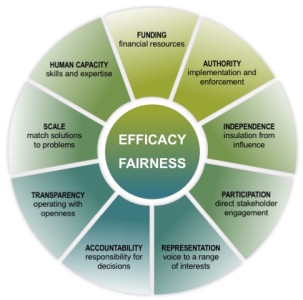The Devil is in the Design: Forming California’s New Groundwater Agencies
By Dave Owen and Mike Kiparsky
Cross-posting from the Environmental Law Prof Blog. This post was written by Dave Owen and Mike Kiparsky. It is based on a recent report, co-authored with Nell Green Nylen, Holly Doremus, Barb Cosens, Juliet Christian-Smith, Andrew Fisher, and Anita Milman.
Not that long ago, the opening words of one of Joe Sax’s articles described California pretty well. “We Don’t Do Groundwater,” the article’s title began, and until recently, that was true—in spite of the immense importance of the resource. Outside of a few urban areas in coastal southern California, California groundwater use regulation was largely an oxymoron.
In 2014, that changed. The California Legislature passed the Sustainable Groundwater Management Act, a statute designed to create comprehensive and, as its name suggests, sustainable management of groundwater. The statute also is designed to promote local discretion and control. While the legislature defined broad goals and conferred oversight authority on the California Department of Water Resources and State Water Resources Control Board—both of which are statewide agencies—primary implementing authority will rest with local groundwater sustainability agencies, or GSAs. Those GSAs are now just beginning their work, and many challenges lie ahead.
This week, UC Berkeley Law School’s Center for Law, Energy, and the Environment (working in partnership with UC Water and researchers from UC Hastings, UC Santa Cruz, the University of Idaho, the University of Massachusetts, and the Union of Concerned Scientists) released a report designed to help these GSAs succeed.

The report begins with the premise that GSA governance systems will help determine the success of SGMA implementation – even the best plan has limited value without an agency that can implement it. To facilitate effective implementation, the report offers a framework for institutional design. More specifically, it identifies a series of criteria for evaluating whether GSAs are likely to be able to govern both fairly and effectively. The criteria – scale, human capacity, funding, authority, independence, representation, participation, accountability, and transparency – should help stakeholders and agencies evaluate whether a GSA will be able to manage groundwater sustainably. The report also draws upon examples from the management of other natural resources to illustrate some of the challenges GSAs are likely to face, and some of the ways other resource management agencies have worked through similar challenges.
Some key recommendations include:
- GSAs should minimize the fragmentation that is so common among California water management. Those GSAs should focus, to the extent possible, on aligning their scale to groundwater basin boundaries, rather than existing jurisdictions.
- GSAs will need to develop a range of expertise, including technical, legal, financial, and management, in order to understand and effectively manage a complex and hidden resource. Funding the development of this human capacity will require giving careful thought to a variety of sources of revenue. State agencies will also need to consider how they can best lend their expertise to local regulatory efforts.
- To avoid the potential for domination by a narrow range of interests, GSAs will need to develop mechanisms for participation and representation of a broad range of stakeholders.
- To ensure accountability, the state needs to be prepared to actively exercise its oversight responsibilities, and to clearly signal now how and under what conditions it will do so.
The report provides more detail on these and other recommendations, and can also serve as a reference to the tools and options available to GSAs. We intend for the report to help the people who staff and manage GSAs as they attempt to meet the challenge of groundwater management, the state agencies who act as the crucial backstop for the act’s implementation, and the many stakeholders who will ultimately benefit from achieving groundwater sustainability in their local basins. California now does groundwater, and we hope this report will help us do it well.






Reader Comments